×
Save 20% On Your Purchase!
Use code SAVE20 at checkout to save on your purchase today from my Herbal Shop!
×
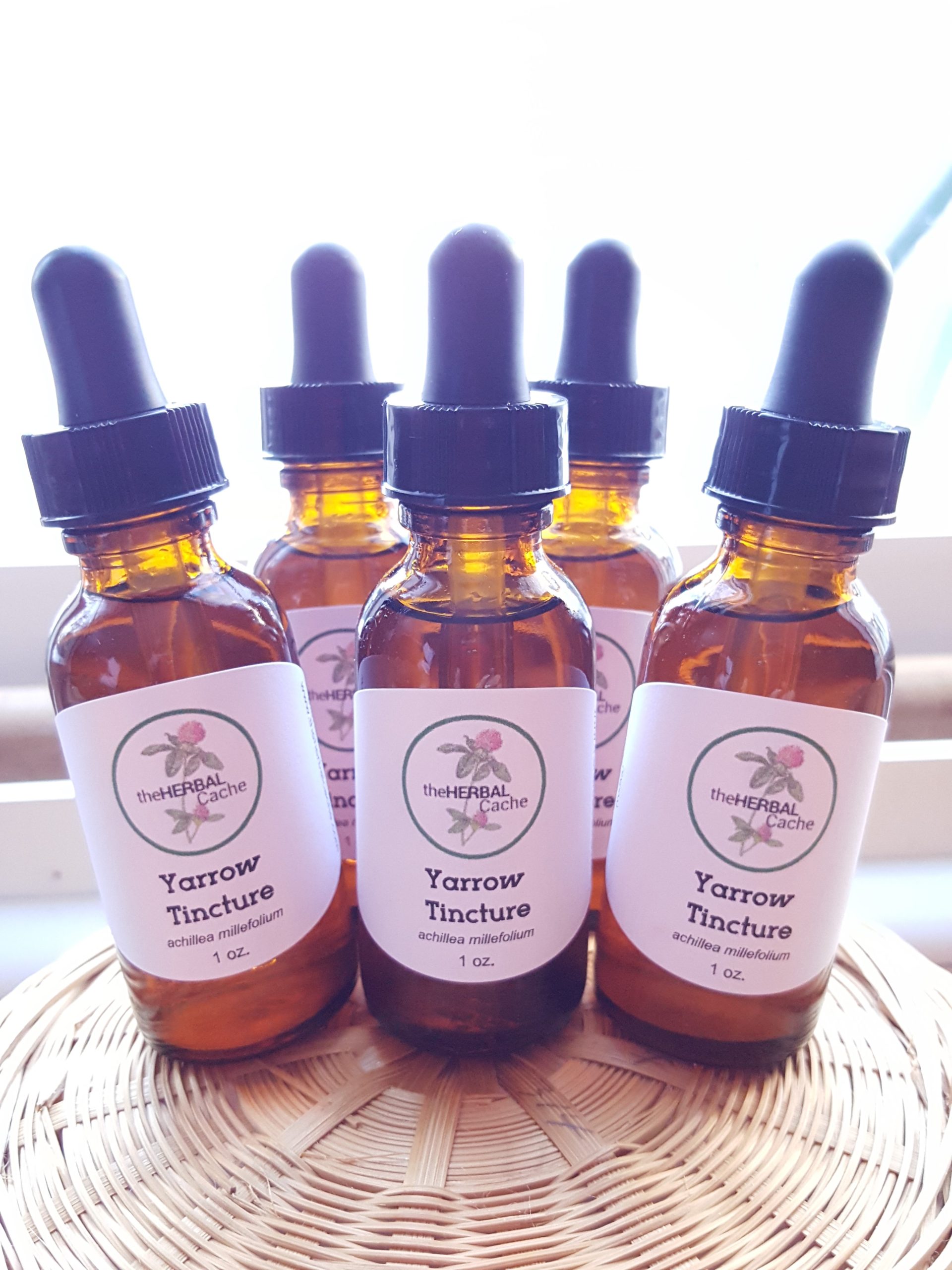
The world is a nettle; disturb it, it stings. Grasp it firmly, it stings not.
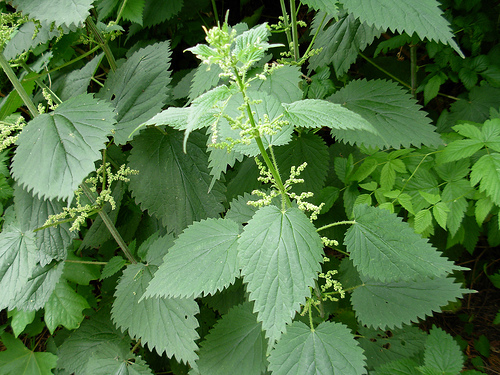
Stinging nettle has been used for centuries to treat various maladies, including anemia, arthritis and skin diseases. Its leaves are edible in salads or cooked like spinach.
And yet many people see it as a weed and want to pull it up by its roots to eradicate it.
But the benefits of stinging nettle include supporting urination, increasing blood flow and reducing neural inflammation.
Let me show you that this plant is more than just a weed.
Stinging nettle is generally considered a weed and can be found growing wild in woodlands and on river banks. It also prefers disturbed soils, such as on farmsteads, manure piles or near abandoned buildings.
Stinging nettles have long fleshy roots that can grow deep into the ground. This is important, because this is how the plant becomes so nutritious, by pulling up vitamins and minerals deep in the soil.
The leaves, stems and roots are covered in tiny hairs that release histamine and other chemicals that can sting painfully. These chemicals cause an itchy, irritating sensation on the skin which only lasts about 15 minutes.
Growing up, my mother called this plant “itch weed”, because it made you itch. So I highly recommended that you wear gloves when handling this plant. Or if you want to get the true feeling of stinging nettle, don’t.
This plant is a very fast grower and spreads easily by seed or underground shoots.
For optimal nutrition and medicinal properties, it should be picked before flowers appear. I like to harvest the tops in early spring when the plants are still young. They will grow back, so you can get a number of pickings.
Susun Weed says to grasp it by a top leaf and cut just the very top (no more than 8 leaves) and put that in the foraging basket. Since nettles are so fibrous, she says to only pick the very tops. If the scissors have difficulty cutting, it’s too far down.
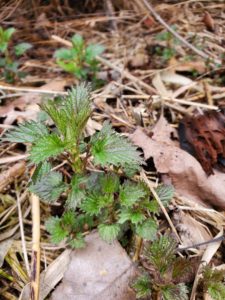
The leaves and young shoots of stinging nettle are edible. They have a slightly bitter, nutty flavor that most find pleasant. Nettle leaves can be a simple substitute for spinach in any dish.
Nettles are rich in vitamins A, C, D and K as well as iron, potassium, calcium and manganese.
One serving of stinging nettle provides almost all of the recommended daily allowance for vitamin K per day.
Nettles are also rich in chlorophyll, which gives them their green color and may be responsible for some of its health benefits.
Two studies published in the “Journal of Agricultural and Food Chemistry” evaluated the antioxidant activity of nettle extract and found it to be higher than other popular drinks like cranberry juice, grape juice and green tea. The researchers concluded that the high antioxidant activity may be due to nettle’s chlorophyll content.
The leaves are said to have a beneficial effect on the urinary system because they contain high amounts of potassium, calcium and magnesium. They also can help reduce inflammation in the bladder lining which may prevent chronic infections from developing.
In addition to its nutritional value, some studies suggest that stinging nettle may also have medicinal properties.
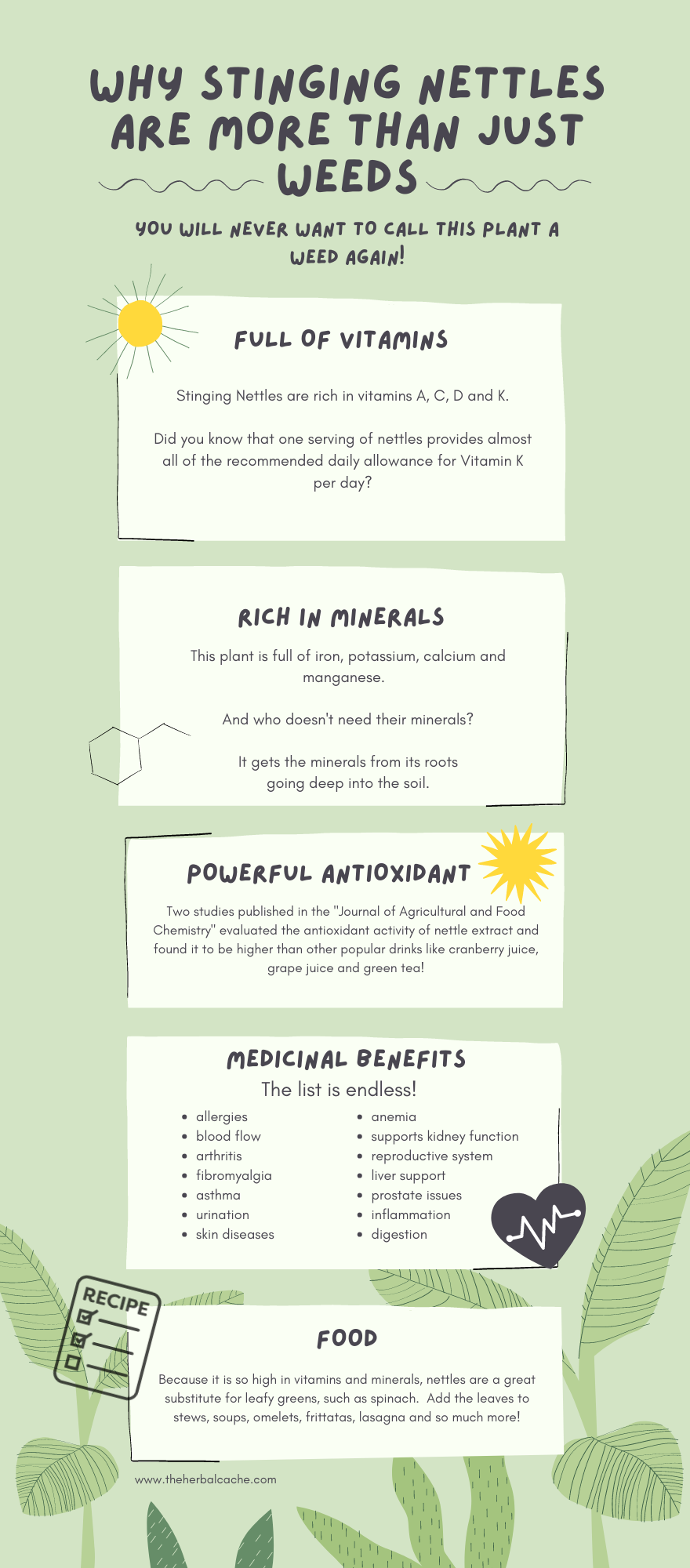
In addition to its nutritional content, stinging nettle is said to have medicinal properties. Its roots and leaves are used in traditional herbal remedies for conditions such as anemia, arthritis and skin diseases. In addition, modern uses include supporting urination and increasing blood flow. Nettle root may also help relieve symptoms of the common cold.
One small study published in the “Journal of Complementary and Alternative Medicine” found that patients who suffered from frequent colds showed a significant decrease in number of colds after taking nettle root extract daily for 12 weeks. These results were not found with the placebo group.
Another study conducted by researchers at the University of Virginia found that drinking stinging nettle tea reduced the total number of colds by more than one-third among patients who suffered from chronic respiratory infections.
Brigitte Mars talks about how people have used nettles for thousands of years to help with pain from arthritis, fibromyalgia and as an early substitute for Viagra! By gently brushing a stem of leaves over one’s skin, the irritation causes a huge blood flow to the area (called irtication). Thus helping with pain, inflammation, etc.
Nettle is a wonderful herb for those with allergies. A study published in “Alternative Therapies in Health and Medicine” suggested that an extract from this plant may reduce inflammatory responses due to allergies, which suggests it may be effective in relieving symptoms of allergies and asthma.
Herbalist Matthew Wood says the seeds in particular, may help get rid of allergies, both food allergies and seasonal ones. He also recommends the root be taken for prostate problems.
Stinging nettle also helps get rid of mucus in the lungs.
David Hoffman calls this plant the “ultimate green tonic”. That should tell you something.
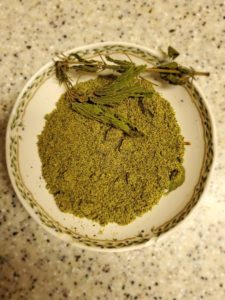
There are a number of ways you can incorporate stinging nettle into your diet.
A very easy way is to cook it like spinach or added to soups and stews for extra nutritional benefit. Herbalist Rosemary Gladstar likes to saute it with a little olive oil, lemon juice and feta cheese.
Herbal Revolution preserves their nettles like this to to enjoy all year:
These little “patties” can be added to soup, pesto, sautéed, in frittata, scrambled eggs, smoothies, etc. This could also be done with dandelion greens!
The young shoots may also be eaten fresh or steamed. But make sure to get the tops of young plants. Nettles are very fibrous in older plants and growth near the ground.
To make stinging nettle tea, steep one teaspoon of dried herb for eight to 10 minutes in hot water. This makes an excellent substitute for coffee that is high in antioxidants and many other nutrients.
People who suffer from chronic conditions like allergies and arthritis may find relief by drinking stinging nettle tea.
Taking nettle in a tincture form is available if you can’t stomach eating the greens, or don’t like drinking teas. As a tincture, it is a more concentrated and you can take it as needed. You can find tinctures in most natural food or wellness stores.
Making a herbal decoction with nettles is another great way to take this plant. Just follow these simple instructions:
My favorite way to use nettles is by making Nettle Gomasio! This herbal spice blend can be used on almost everything. I personally like it on my fried eggs and popcorn.
In the video below, I show you just how easy it is to make your own Nettle Gomasio!
I hope I have shown you just how beneficial stinging nettles are for us.
Not only are they nutritious in terms of the vitamins and minerals they provide, but they also help support our health and body in a number of ways.
Nettles have been around for thousands of years, and I hope they will be around for a thousand more. Because we need them.
So go and “nettle” up!

“An anthology is like all the plums and orange peel picked out a cake.” Walter Raleigh
Eat orange peels?
Now most of us will drink orange juice or eat the inside slices of an orange. But the peel? Too bitter!
But before tossing that orange peel into the garbage, continue reading and be amazed!
The peel has so much to offer us in terms of medicinal properties and keeping us healthy. It has been used for thousands of years to treat different ailments.
Orange peel contains a large amount of Vitamin C and is a powerful antioxidant.
So lets learn a bit about how orange peel is good for us, make a cup of orange peel coffee, look at ways to get orange peel into your diet, and lastly, check out other ways to use up those orange peels.
In Need of Organic Orange Peels?
You can save the peels from organic oranges you purchased and dry them yourself. Easy peasy.
Or you can purchase them from Mountain Rose Herbs, who stand for organics, fair trade, sustainability and more.
Orange peel, along with other citrus fruits, have been used for thousands of years as medicine.
It contains flavanoids, Vitamins A, C, B5 and B6, calcium, riboflavin, thiamine, niacin, folate and dietary fiber.
Lets look at the 21 ways orange peel has been used over the years to help with overall health and how you can benefit.
1. Diarrhea
2. Indigestion
3. Constipation
4. Cleansing
In Traditional Chinese Medicine (TCM), the orange peel has been used for hundreds of years to help with gas, bloating and other digestive issues.
The orange peel contains pectin, which is a beneficial carbohydrate that the good bacteria in your gut feed off of.
5. Colds
6. Coughs
Because of its antibacterial, antifungal and antiviral properties, orange peel is a great for warding off cough and colds. It helps in getting excess phlegm out of the lungs.
7. Weight Loss
8. Obesity
9. Athletic Performance
A team of scientists in Taiwan researced the effects of four different orange peel varities, and found that they remarkably reduced the production and accumulation of triglycerides in fat cells.
10. Cholesterol
When taking in large amounts of orange and orange peel, the HDL increases, while the LDL decreases, which is great for those with high cholesterol.
11. High Blood Pressure
The potassium in orange peel plays a huge role in lowering the risk of high blood pressure.
12. Anxiety
13. Stress
14. Hypertension
15. Depression
Studies are now showing that by just inhaling the aroma of orange and orange peel, can have an uplifting effect on people.
16. Arthritis
17. Rheumatism
Orange peel contains powerful anti-inflammatory agents that help with swelling, redness and inflammation.
18. Asthma
19. Oral Health
20. Hangovers
21. Poor Circulation
So how can you get more orange peel into your diet? Let’s start with a cup of Orange Peel Coffee and then look at more ways to use those peels.
This coffee recipe is not only easy to make, but so good to drink!
Coffee has always been associated with caffeine and a morning pick-me-up. This cup of freshness is much more.
Smelling the citrus aroma while the orange peel is steeping in the hot coffee is just up-lifting.
Are you ready for some?
Here is the recipe for Orange Peel Coffee. I’ve taken it from HERE and adapted it to my tastings. That’s what makes this recipe so wonderful! You can adjust it to your likings.
Orange Peel Coffee
Ingredients:
Directions:
Enjoy my fun little video below on making Orange Peel Coffee!
Besides eating orange peel, there are a number of other uses for orange peel, so don’t throw it out! Unless it’s into the compost pile.
Here is a list of uses:
https://www.motherearthliving.com/cooking-methods/citrus-peel-medicine-coffee
https://www.webmd.com/vitamins/ai/ingredientmono-908/sweet-orange
https://www.motherearthliving.com/health-and-wellness/citrus-peel-medicine
https://www.linkedin.com/pulse/25-proven-health-benefits-orange-peel-tea-dr-paul-haider/
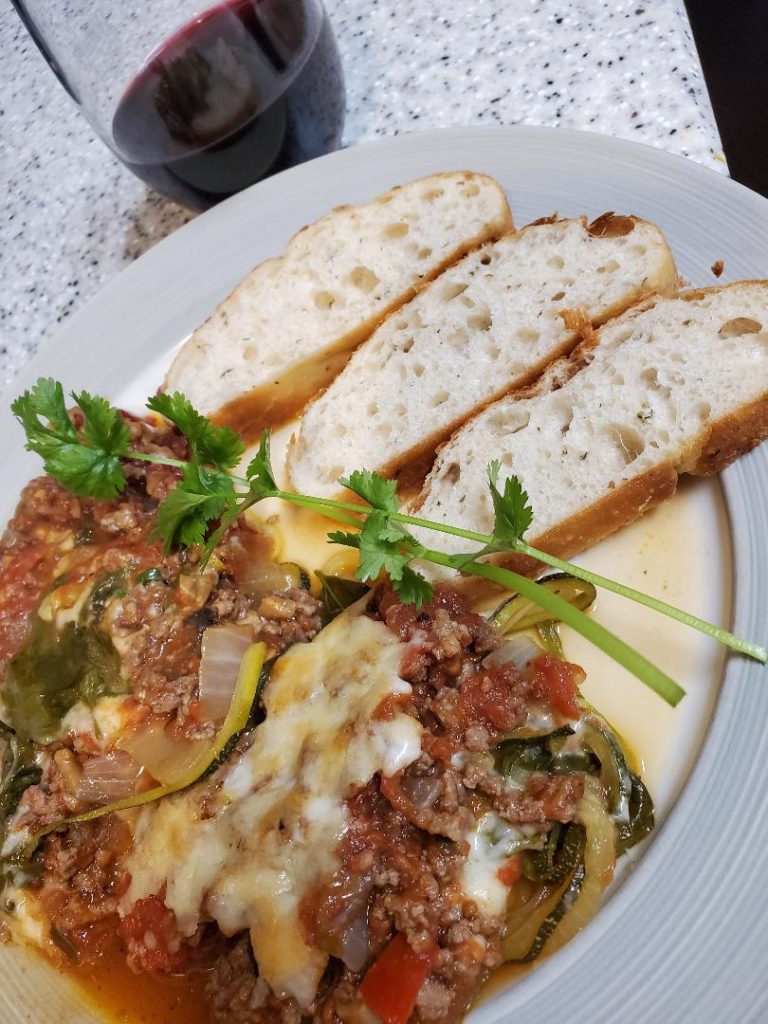
I’m the type of person who doesn’t like to waste anything I don’t have to. So when I saw all the lambs quarters in my mom’s garden that she wanted pulled out, I knew I had to step in and utilize them.
Now my mother tends a very large garden, and always has. With the help from a few of my siblings, we help plant and take care of it through the summer. Then in the fall we all benefit from our labor of love with some wonderful vegetables. This is a wonderful time for us to bond as siblings and family as well.
It is always fun to think ahead to the harvesting and canning of the delicious vegetables. Some of our favorites are making salsa with all the tomatoes and peppers and booyah, which utilizes just about every vegetable from the garden, with the addition of chicken.
Right now we are in the middle of summer and working on maintaining the garden, such as watering and weeding. Yes, I said weeding. But not just any weeding.
In this garden are many “weeds” (according to my mother), such as lambs quarters and amaranth. So instead of just pulling and tossing the weeds, I collect them. This time I collected lambs quarters for eating.
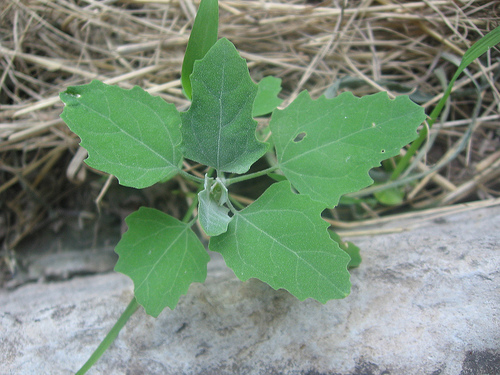
Lambs quarters, also known as wild spinach, is very nutritious and can be eaten like any other green. It is one of the most common weeds you will find in gardens and backyards.
So you definitely don’t want to toss out such a plant! Well, I least I don’t.
I took the lambs quarters I collected and created a casserole dish that is absolutely divine! And I wanted to share it with you so you can enjoy this wonderful plant too.
So the first thing you will need to do is to gather about 5-6 cups of lambs quarters leaves. If you have little ones, this would be a great way to have them help you out. They can help pick leaves for you! Once picked, rinse them and let drain.
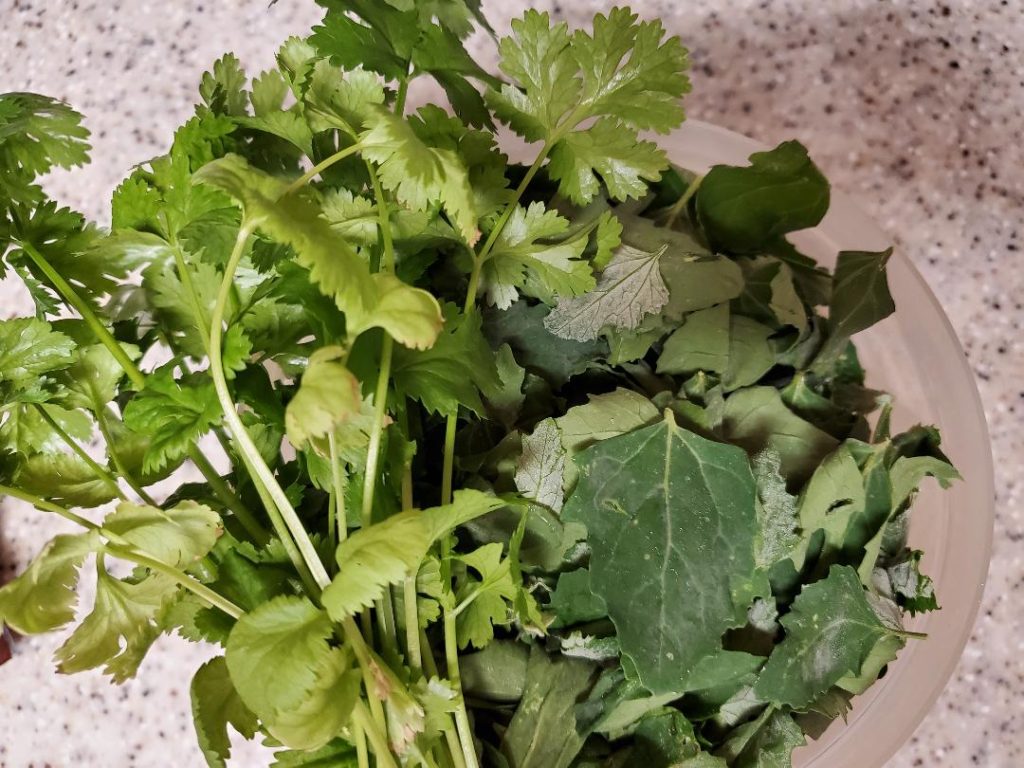
Then, over medium heat, brown the ground beef in a fry pan. I add in the onions and mushrooms when the hamburger is almost done browning. Once the onions are translucent, drain off any excess grease.
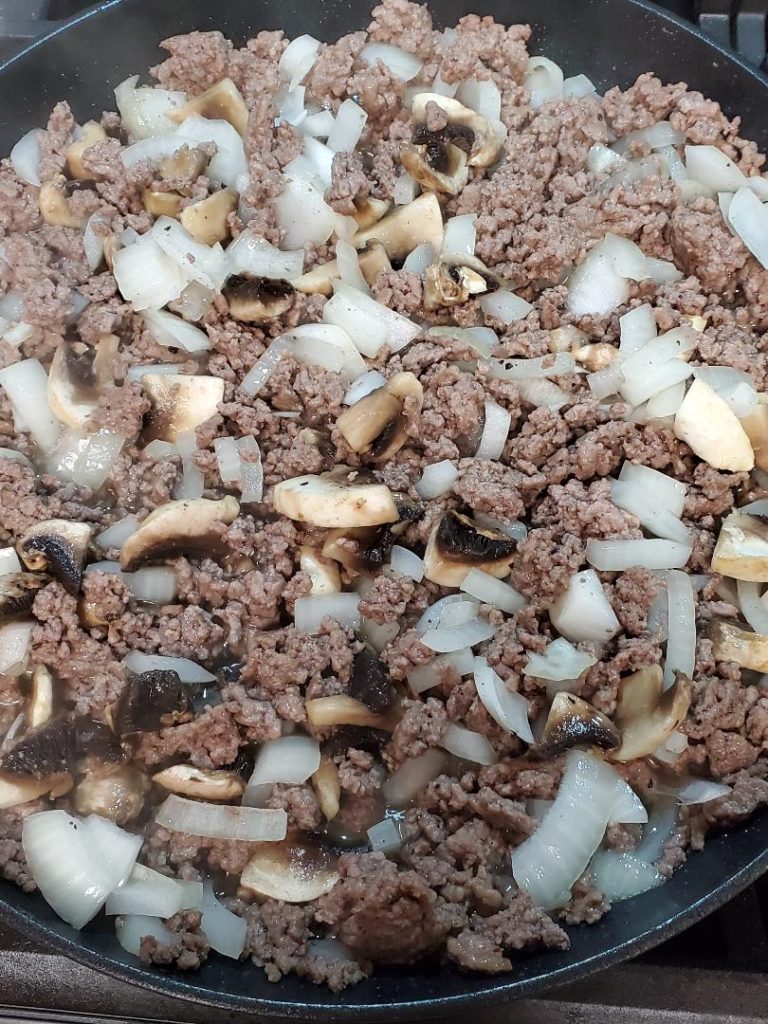
While the ground beef or hamburger is browning, you can prepare the zucchini. I like to spiralize mine. You can either buy it spiralized, or buy whole zucchini and do it yourself. I like this spiralizer. It is simple to use and cleans up nicely.
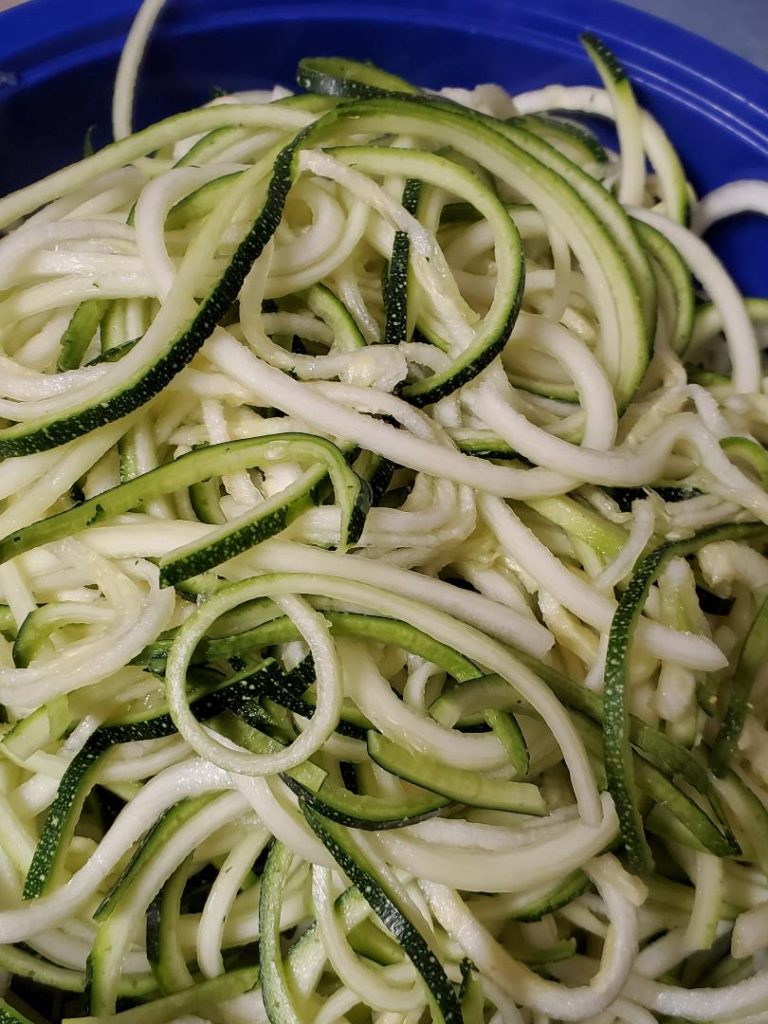
Now you can start pre-heating your oven to 350 degrees.
Once you have the ground beef browned and the zucchini prepped, it is now time to put your casserole together.
Get out a glass casserole dish or cake pan. Spread a couple scoops of spaghetti sauce on the bottom to help prevent the other ingredients from burning to the bottom. Then start layering the zucchini, ground beef, lambs quarters, cilantro, cheese and sauce.
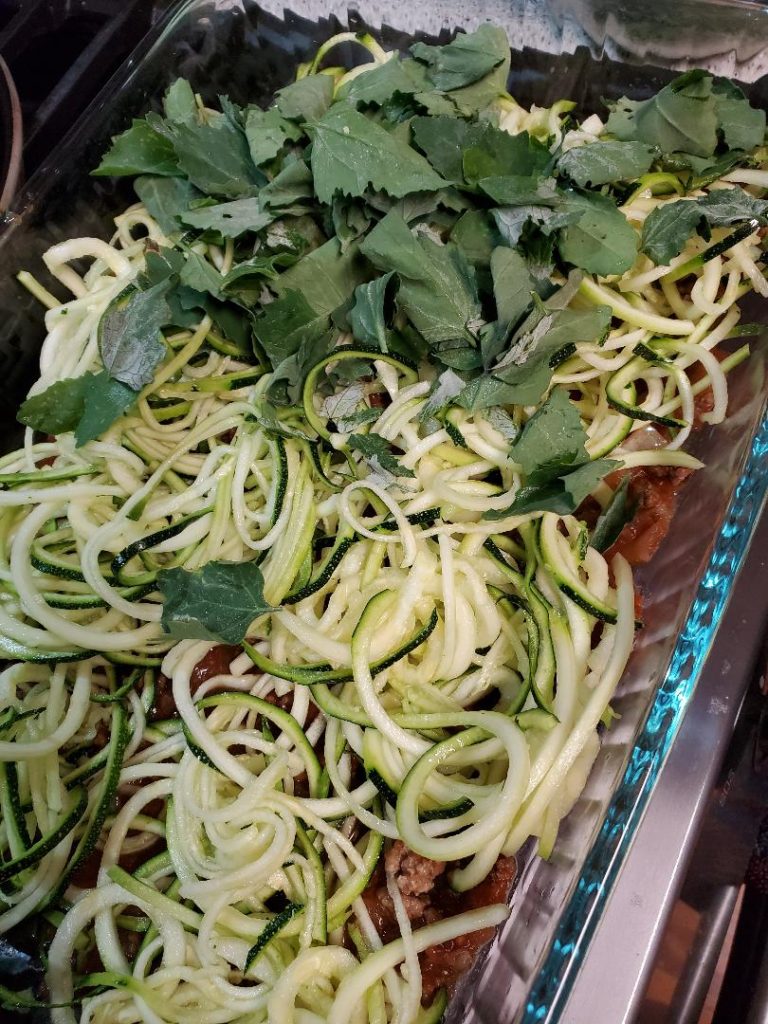
Keep layering till all ingredients are gone. Top the dish off with cheese. You can use more or less cheese, however much you prefer. I usually end up with about 2 layers of each ingredient before the pan is full.

Once the oven is pre-heated to 350 degrees, put the casserole in the oven to bake for about 30-45 minutes, or until the cheese is starting to turn brown.
I serve this with some garlic bread and a side salad. It is a very nice way to enjoy an Italian style dish without the pasta and carbs.
And of course, I have to have a nice glass of red wine to accommodate the meal.
I hope you enjoy this simple and nutritious dish as much as I had fun creating it.
Bon appetit!
[recipe title=”Lambs Quarters and Zucchini Casserole” servings=”6-8″ preptime=”30 mins” cooktime=”30-45 mins” difficulty=”easy” rating=”★★★★★” image=”https://www.theherbalcache.com/wp-content/uploads/2020/06/out-of-the-oven.jpg” description=”A healthy take on lasagna without the pasta.”]
[recipe-notes]
Credit: theherbalcache.com
[/recipe-notes][recipe-ingredients]
– 1.5 lbs ground beef
– 1 medium chopped onion
– 1/2 cup mushrooms
– 2 zucchini, spiralized
– 5-6 c. fresh lambs quarters
– 1 c. chopped cilantro
– 1 jar spaghetti sauce (I like to use my homemade sauce)
– 3 c. mozzarella cheese
[/recipe-ingredients][recipe-directions]
1. Brown the ground beef; add the onion and mushrooms and cook until onions are translucent.
2. Layer the hamburger mixture, zucchini, lambs quarters, cilantro, cheese and sauce. Add another layer of cheese on top.
3. Bake at 350 degrees for about 45 minutes or until cheese starts to brown up.
[/recipe-directions][/recipe]
I love seeing virginia waterleaf coming up because I know that spring is here and winter is behind me. Here in central Minnesota, it is one of the first spring ephemeral plants to emerge from the cold ground. Sam Thayer calls it an “optional ephemeral” because it is abundant in the spring, but becomes sparse in the summer months.
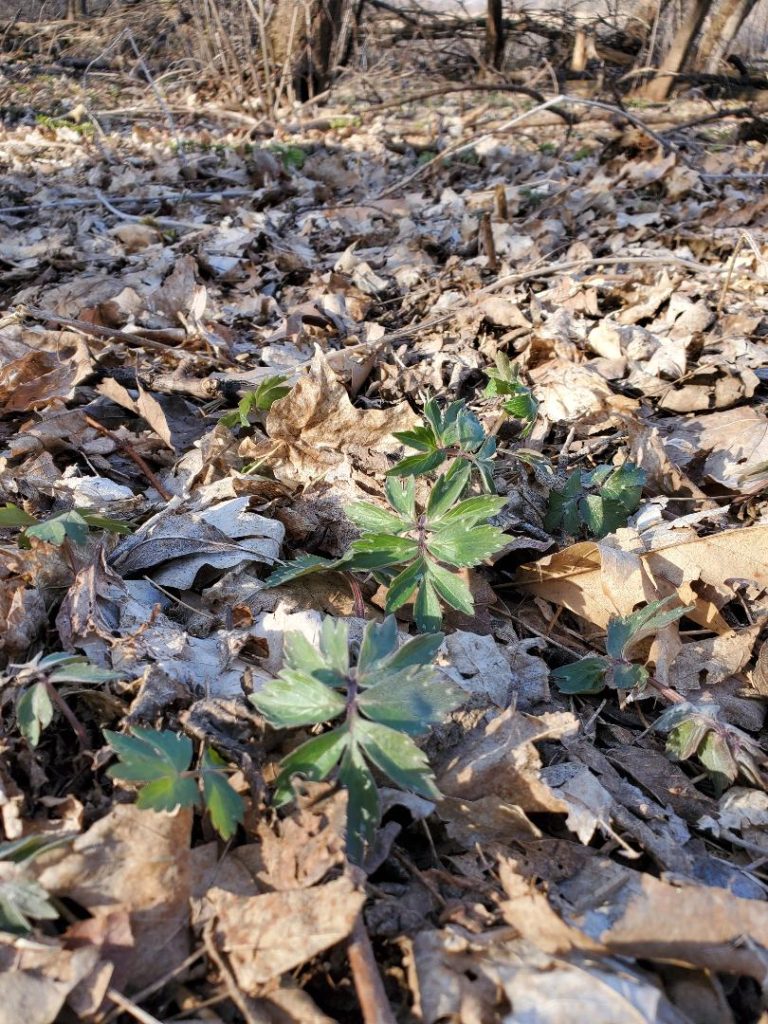
Virginia Waterleaf emerging from under the dead leaves in early April.
Hydrophyllum virginianum
The generic name, Hydrophyllum, is Greek for “water leaf”. Hydro is from hudor or hydor, which is “water”, and phyllum is from phullon or phyllon, which is “leaf”. This name also refers to its wetland habitats. The specific epithet, virginianum, is Latin for “of Virginia”, where it was first studied.
You can easily identify virginia waterleaf in the spring because of the distinctly spotted leaves, giving it the appearance that it is stained by water drops. Virginia waterleaf is one of the most prolific varieties, and it flourishes far past Virginia into areas such as Minnesota.
Virginia waterleaf is a herbaceous perennial in early summer. It can be found mainly east of the Mississippi River, but it has western cousins, the California waterleaf (Hydrophyllum occidentale) and the Pacific waterleaf (Hydrophyllum tenuipes).
Although this plant is fairly competitive with other plants, there are some areas, such as New Hampshire in which this is becoming endangered.
Bees and white-tailed deer love this plant for gathering nectar and eating.
Other common names for this species are Brook Flower, Burr Flower, Eastern Waterleaf, Indian Salad, John’s Cabbage, Shawanese Lettuce, Shawnee Lettuce, Shawnee Salad, Virginian Waterleaf, and Waterleaf.
Virginia waterleaf can be found growing in wet, wooded areas. It prefers shade. It likes a a moist humus-rich soil. Slugs are particularly fond of this plant and will soon destroy it if given a chance
The plant grows in a clump like format with limited spread. The root pattern is rhizomatous with underground stems sending roots and shoots along their length. The clumps can easily be propagated in the spring.
This plant is considered a nice groundcover by many gardeners.
In early spring, Virginia waterleaf can be easily identified by the spots on the leaves, appearing to be waterdrops, hence the name. The leaves are deeply lobed, with jagged edges, and get darker as the plant matures.
It flowers in May to early June and seeds in July and August, lasting 3-4 weeks. The flowers form in dense clusters and are are white to dark violet in color.
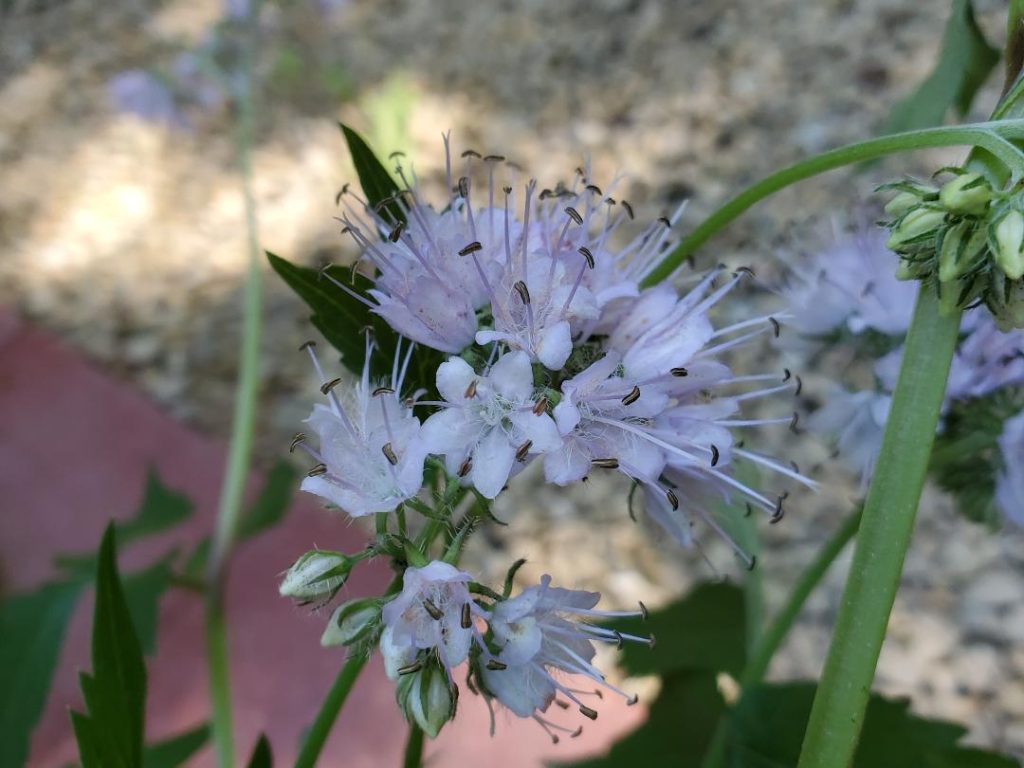
The leaves are alternate with the stems being slightly jointed. The stem is covered with dense, stiff hairs. Where the plant divides, the stem is more red or purple in color. The plants get about 2 feet tall.
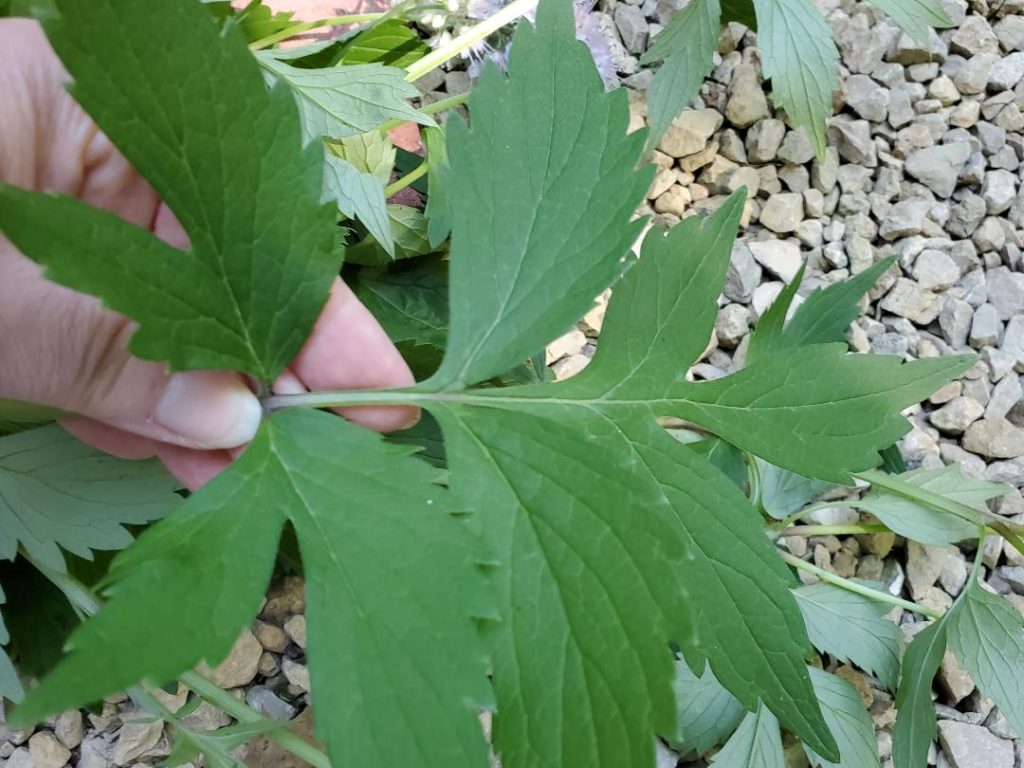
Both the Native Americans and the early European settlers used this plant.
Known also as Indian Salad, the leaves taste a bit like parsley and are good in salads this time of year or in soups as a potherb. The leaves are also good fried in fat or oil when they are tougher.
The leaves can be eaten when young. They have a rather bland taste and are a nice addition to any leafy salad. The leaves do have a slightly fuzzy texture, but when mixed with other greens, you don’t notice it. The older leaves can be eaten as well, and are more like spinach. According to Sam Thayer, they are to be eaten like most greens, used as a side dish or snack, not a main dish.
The flowers and flower buds can be eaten. Add them to a salad for decoration and to eat! The buds are similar to the raabs of garlic mustard and bittercress. Mix them with the leaves and some other greens and they make a fun, textural addition to the salad.
The leaves and flowers can be eaten raw or cooked. When cooking, it is recommended to boil twice with fresh water to remove some of the bitterness. The cooked leaves and shoots can be served with salt, pepper, butter, or vinegar. The leaves and shoots are best eaten before the flowers emerge.
Some Native American tribes fed the roots to their ponies to fatten them and to shine up their hair.
Minnesota herbalist Matthew Alfs says virginia waterleaf is a first-rate astringent and sadly ignored by herbalists. He says it is his go-to remedy for those with oral sores.
A tea made from the roots as an astringent, can be used in the treatment of diarrhea, dysentery etc. A decoction, or the chewed root, has been used as a wash for cracked lips and sore mouths.
Historically, it was used for pain. The Menominee used the roots for chest pain and the Ojibwe used it for back pain.
Using this plant in tea form is the most common usage, but it can also be made into a tincture. I prefer the tincture form because it has a longer shelf life.
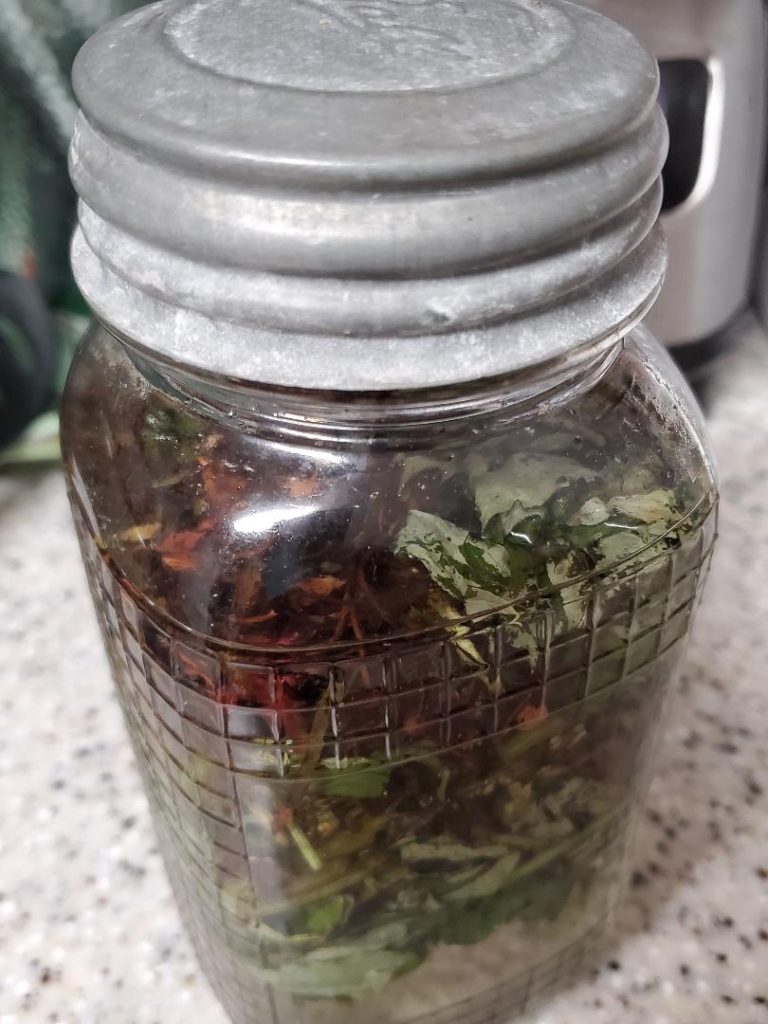
I use the entire plant to make a tincture. This way I get the whole plant’s synergy into my medicinal liquid extract.
I suggest you keep a watch for this hidden little gem of a plant. In the early spring, take a nibble on a leaf and see what you think. Or just admire the ornamental flowers sticking up above the stems. Either way, I think you’ll find that this plant has a personality all its own!
Thayer, Samual (2006). The Forager’s Harvest: A Guide to Identifying, Harvesting and Preparing Edible Wild Plants. Birchwood, WI: Forager’s Harvest
Alfs, Matthew (2013). Edible and Medicinal Wild Plants of the Midwest. New Brighton, MN: Old Theology Book House
http://www.naturalmedicinalherbs.net/herbs/h/hydrophyllum-virginianum=virginia-waterleaf.php
http://www.wildfoodies.org/EasternWaterleaf.htm
https://pfaf.org/user/Plant.aspx?LatinName=Hydrophyllum+virginianum
https://practicalplants.org/wiki/Hydrophyllum_virginianum
https://www.ediblewildfood.com/virginia-waterleaf.aspx
http://www.illinoiswildflowers.info/woodland/plants/va_waterleaf.htm
The dandelion, queen of weeds, shows us simplicity, beauty, resilience and stamina.
Pam Broekemeier

Varicose veins are part of getting older for some of us. As our bodies start taking the tole of our past years, it starts to show physically. You could say that is a sign of learned knowledge. But, for most of us, we would rather not show so many signs of getting older.
For now, lets take a look at one physical feature that many people are concerned about, and those are varicose veins. We’ll look at what they are, how they come to be and some natural ways one can try to subdue them.
Varicose veins are enlarged veins that have pushed themselves outward, just below the skin. They are most commonly found on the legs and feet, yet can affect any vein in the body.
Most are harmless. They are just a cosmetic issue for some people.
For some, varicose veins can be painful or sore. They can also cause issues for blood circulation. That can bring on swollen ankles, itchy skin and achy limbs.
Veins are continually working against the forces of gravity as they push blood back to the heart. Veins must be kept healthy and strong to maintain this level of work.
There are “valves” in the veins that push the blood back to the heart. Valves and muscles work together to get the job done. So if the muscles weaken, so do the valves.
As the valves and muscles weaken, blood starts to pool in these areas, which leads to varicose veins.
A variety of things can cause the weakening of valves and muscles. Some of those include obesity, being sedentary (which causes muscles to weaken), standing for a long period of time, pregnancy, menopause, aging, genetics and walking.
Poor blood circulation is also key in varicose veins, and a number of other health issues. Lack of concentration and low energy levels can also be due to poor blood circulation. Here is an article from The Lost Herbs, DIY Lost Circulation Booster, that can shed more light on this topic and a way to correct the issue.
The primary symptom of varicose veins is visibility. They become swollen, misshapen veins on ones legs. Some people will also have pain, heaviness and achiness near these veins.
Swelling can also occur in the lower legs and ankles after standing for periods of time.
In severe cases, the veins can bleed and ulcers may form.
According to WebMD, varicose veins can sometimes be genetic, and women are twice as likely to develop them over men.
About 23% of Americans are affected in some way.
There are a number of things a person can do to help control and lessen the issue. The Mayo Clinic suggests exercise, elevating ones legs and wearing compression stockings.
Also, losing weight or maintaining a healthy weight can help minimize or prevent them as well.
Surgery is an option for those where lifestyle changes aren’t improving the condition or there is just too much pain. More information on surgical procedures can be found here.
Using herbs and plants is another way to deal with this issue.
One can look to herbs and plants to help with varicose veins in a natural way.
A number of herbs that can be used to minimize the effects of varicose veins are known as astringents. They help by tightening the tissues and getting them back to their original state, as best they can.
Some of these herbs include:
(helichrysum italicum) is named after the golden yellow flowers of the plant, and comes from the Greek words helios meaning sun and chrysos meaning gold. A common name for it is Immortelle.
Helichrysum has many medicinal properties and is known for its restorative and rejuvenating properties. It helps heal scars and supports cell growth by encouraging the recycling of dead cells and stimulating production of new ones.
This yellow flower can also be used to help with inflammation and clears blood clots by liquefying/thinning them.
Helichrysum is an anti-oxidant as well.
(aesculus hippocastanum), also known as buckeye in some parts, or conker tree in Europe.
Horse Chestnut supports blood circulation, thus helping those with varicose veins. As an astringent, it helps to tone vein walls which, when slack or distended, may become varicose, hemorrhoidal or otherwise problematic.
Aescin, a constituent found in horse chestnuts, performs an antioxidant function and has a general vasoprotective role by protecting collagen and elastin (the two chief proteins that form the structure of veins). There are multiple clinical studies showing that horse chestnut helps in reducing inflammation, alleviating circulatory problems affecting the legs and reducing varicose veins.
You can find our more about how horse chestnuts help with varicose veins in this article, “How to Treat Varicose Veins with Chestnuts“.
(quercus alba) is a tree native to North America and was used by Native Americans for many conditions. Throughout history, it has been known as a symbol of strength and endurance.
White oak is an astringent, due to its high level of tannins, and helps with inflammation and skin conditions, such as varicose veins.
It is also an antiseptic, so helps control infection internally and externally.
White oak also contains quercetin, which helps in strengthening the capillaries and veins.
Did you know you can grind the acorns into a flour? Pretty cool!
(Salix alba) has been used medicinally for over 5000 years. It is native to Europe and Central Asia.
The bark is known as being the original pain reliever because it contains salacin, which the body converts to salicylic acid. Thus if helps reduce fevers, pain and inflammation. It takes a little longer to work, but lasts much longer then aspirin and has less side gastronomic side effects due to the large amounts of tannins that protect the stomach.
The inner and outer barks have slightly different concentrations of compounds for different ailments.
Willow bark’s high concentration of antioxidants make it very beneficial for the health of the skin. It increases blood flow to the skin, which helps to reduce wrinkles and age marks.
(Hamamelis virginiana) is a fairly common shrub found in North America. Native Americans used it to help treat skin irritations and tumors.
Witch hazel is a great skin treatment because of its astringent properties. It helps with stretch marks, wrinkles, acne, hemorrhoids and varicose veins. It is also good for itchy skin when dealing with chickenpox, eczema, bug bites and poison ivy.
Witch hazel’s ant-inflammatory properties also make it a go-to for diaper rash and sunburns. Regular application helps in healing the damaged skin quicker.
Daily use of witch hazel helps to kill bacteria living on the skin and supports cell growth. It also helps to remove excess oil from the skin.
(Achillea millefolium) originated in Europe. It can now be found in many parts of North America. The Greeks used yarrow over 3000 years ago to treat wounds. The genus name, Achillea, honors the Greek hero Achilles; who reportedly used yarrow for himself and for his soldiers as a treatment for battle wounds. Yarrow was also commonly used during the Civil War to stop wounds from bleeding.
When used topically, yarrow is wonderful for helping with skin issues, such as rashes, hemorrhoids, varicose veins or broken wounds. It supports blood circulation, reduces blood stagnation and helps to tone vein walls with its astringent properties.
Herbal Products or DIY
One can make their own creams or ointments to help with varicose veins by using some of the herbs mentioned above. One place to purchase these herbs is at Mountain Rose Herbs.
If one can’t or doesn’t have the time to make a cream or ointment, I offer a wonderful cream for varicose veins that not only helps minimize them, but softens and hydrates the skin as well.
Another way to utilize herbs in controlling or minimizing varicose veins is by using tinctures topically. Put the tincture directly on the varicose veins and let dry on the skin, or use a cloth soaked with the tincture to lay directly on the veins for a period of time.
Using this natural method will take a little bit of time to see results, so one has to be patient. It took years for the varicose veins to appear, so they won’t disappear overnight.